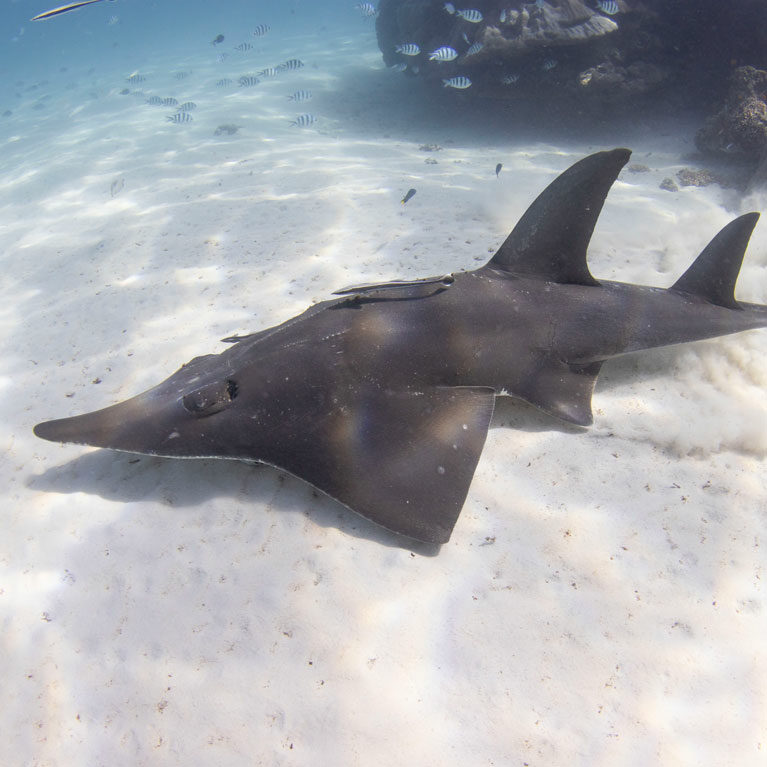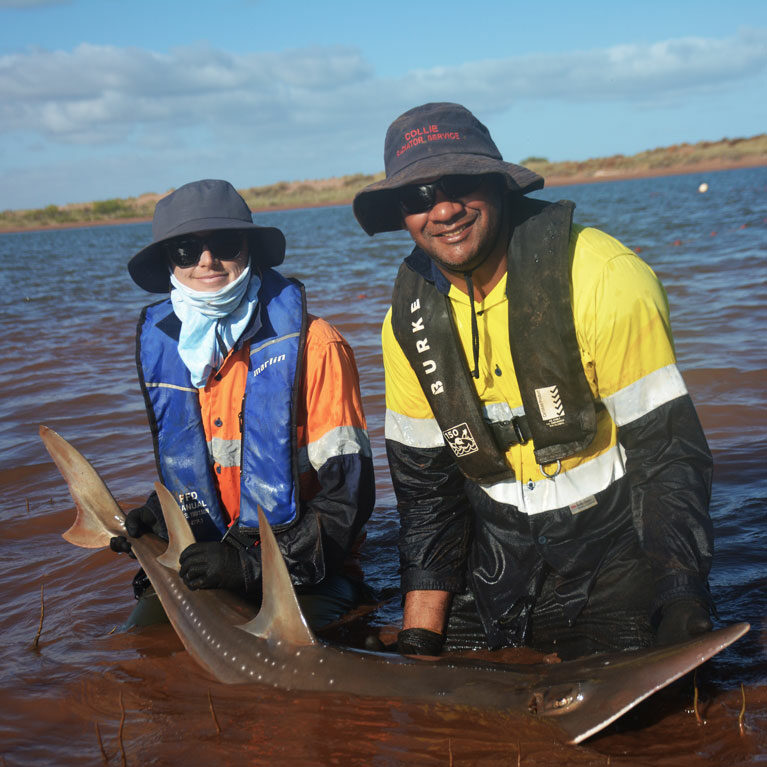Tracks: tagging the shark-like rays of Pilbara
Karissa is using acoustic telemetry to track wedgefishes and the giant guitarfish to fill in the gaps on where these species move and how deep they swim in the Pilbara region of Western Australia. She will be updating anecdotal information that guides where these shark-like rays can be found and will add her findings about how they live, so that the correct management plans can be put in place for the Critically Endangered species.
When people asked me as a kid what I wanted to be when I grew up, my answer was always ‘I want to be happy!’ I suppose I should have known then that what that meant for me was being a marine scientist. As a child I loved to go down to the beach and search through tide pools for sea cucumbers and anemones. I was thrilled by the sheer volume of organisms fighting for every inch of space on the beaches and by their incredible tenacity for life. From there I was hooked and took every opportunity to learn...


Tracks: tagging the shark-like rays of Pilbara
This project will determine the distribution, population densities, and potential nursery habitats of the bottlenose wedgefish (Rhynchobatus australiae) and giant guitarfish (Glaucostegus typus) in the Pilbara region, Western Australia. Through acoustic tracking, we will also examine habitat use and movement patterns of guitarfish and wedgefish in such nursery areas.
This project focuses on two highly threatened species for which we have very limited scientific knowledge of their biology or ecology, in a highly remote region of Western Australia where few directed elasmobranch surveys have been conducted. Many of the locations we will survey have not been previously examined in any scientific capacity, largely because they are difficult and costly to access. However, the limited evidence available suggests that these areas are important habitats for wedgefishes and giant guitarfishes. The project complements a study already in progress, examining sawfish populations in the region, which includes full funding for all travel and survey trips, enabling sampling of the remote locations. The project is therefore a unique opportunity to achieve high scientific returns for low costs, enabling some of the first focused research on highly imperiled wedgefishes and guitarfishes, in pristine environments in highly remote field settings.
Two wedgefish and guitarfish species that have ‘lifeboat’ populations in Australia are the bottlenose wedgefish (Rhynchobatus australiae) and the giant guitarfish (Glaucostegus typus), which have both recently been defined as Critically Endangered under IUCN criteria (Kyne et al., 2019). While both species have suffered large declines in the Indo-West Pacific areas of their range due to overexploitation, populations in Australia remain relatively intact (Kyne et al., 2019), making conservation of the Australian populations essential for the global persistence of these species (Moore, 2017). Both species are distributed across the northern half of Australia (Last et al., 2016), and the presence of these species in tidal creeks near the Ashburton River estuary, Western Australia, has recently been confirmed through a preliminary survey, which also identified a potential nursery area for giant guitarfish (D. Morgan and K. Lear, unpublished data).
This project aims to determine the specific distribution, habitat use, and movement patterns of wedgefishes and giant guitarfishes in the southern Pilbara region, Western Australia. The remote habitats in this region are relatively pristine, with little anthropogenic influence, maintaining intact habitats for many elasmobranchs and other coastal aquatic species. However, there is mounting pressure to develop parts of the region for natural resource use, particularly from oil and gas and mining operations. There is therefore an urgent need to determine the habitat requirements and distribution of these animals in this region to promote effective conservation for these species and their ecosystems.
Kyne, P. et al. (2019). The thin edge of the wedge: extremely high extinction risk in wedgefishes and giant guitarfishes. bioRxiv, doi:http://dx.doi.org/10.1101/595462
Last, P. et al. (2016). Rays of the World. CSIRO publishing. Moore, A.B.M. (2017). Are guitarfishes the next sawfishes? Extinction risk and an urgent call for conservation action. Endangered Species Research, 34:75-88.
Moore, A.B.M. (2017). Are guitarfishes the next sawfishes? Extinction risk and an urgent call for conservation action. Endangered Species Research, 34:75-88.
- Determine the distribution, population densities, and potential nursery habitats of the bottlenose wedgefish (Rhynchobatus australiae) and giant guitarfish (Glaucostegus typus) in the Southern Pilbara region, Western Australia, through gillnet and visual boat surveys.
- Examine the fine-scale habitat use and movement patterns of both species in the Ashburton River estuary through acoustic tagging and tracking, taking advantage of an acoustic array in the area maintained through complementary work.
- Use the data obtained in objectives 1 and 2, we aim to identify critical wedgefish and guitarfish habitat and their relation to environmental factors, such as bathymetry, habitat type, temperature and other oceanographic variables.

